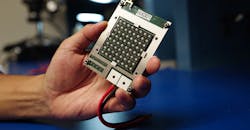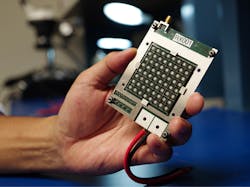Startup Makes 5G its Priority
For Movandi, a venture-backed startup company, the focus is on delivering millimeter-wave solutions for next-generation 5G communications. Pursuant to that goal, the company recently made two announcements that should pique everyone’s interest.
The first of these revealed a collaboration between Movandi and Keysight Technologies, enabling Movandi’s BeamX technology to be tested and validated. “We started working with Keysight as soon as we wanted to verify our solution,” says Maryam Rofougaran, Movandi’s co-CEO/COO. “We’re using a variety of equipment, such as the PNA-X, which allows us to measure all the key parameters for the power amplifier (PA) and low-noise amplifier (LNA). In the future, we’re hoping the equipment will be more advanced and you can do over-the-air (OTA) dynamic testing with more sophisticated, compact, and efficient equipment than what is available today.”
In a subsequent announcement, Movandi revealed that it has begun sampling its RF front-end solution, known as BeamX, for fixed and mobile networks (see photo). The 28-GHz BeamX RF front-end solution integrates power amplification, low-noise amplification, up/down frequency converters, and frequency synthesis. It is also scalable, as it supports array sizes ranging from 16 to 256 elements.
Shown is Movandi’s BeamX solution.
“Our solution is modular, so it’s not really addressing one application,” says Rofougaran. “Since it supports anywhere from 16 to 256 elements, our solution addresses a broad range of applications from mobile devices to base stations.
“Our 28-GHz solution has dual-polarization and dual-beam capability, which could function simultaneously,” she adds. “We can support as many as 32 beams if we implement 256 elements. Companies that are making base stations usually want to be able to create more than just one beam. I think we offer more than enough for those applications.”
System-level calibration that allows for on-the-fly adjustments is another feature. “You have this whole array and you need to make sure that it’s optimized for performance,” Rofougaran notes. “You need to make sure that there is calibration that basically adjusts the gain and phase of the PA so that you get the best and most efficient performance from the array. Those are the kinds of implementations we have in our solution, and it improves the overall yield for volume production as well.”
High-speed beamforming is another benefit of the 28-GHz BeamX solution that should be pointed out. “We can do beamforming in less than 100 ns, which is a really good number for the low latency that is required for 5G,” she explains.
The 28-GHz solution is sampling right now. Rofougaran says the 39-GHz solution is currently being tested, with a goal of providing samples in a few months.


